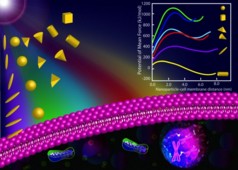Home > Press > Modifications of a nanoparticle can change chemical interactions with cell membranes
 |
Abstract:
Researchers at Syracuse University's Department of Biomedical and Chemical Engineering at L.C. Smith College of Engineering and Computer Science are studying the toxicity of commonly used nanoparticles, particles up to one million times smaller than a millimeter that could potentially penetrate and damage cell membranes.
Modifications of a nanoparticle can change chemical interactions with cell membranes
Syracuse, NY | Posted on January 25th, 2013In a recent article published along with cover art in the leading journal Langmuir entitled "Effects of nanoparticle charge and shape anisotropy on translocation through cell membranes," researchers Shikha Nangia, assistant professor of biomedical and chemical engineering (BMCE), and Radhakrishna Sureshkumar, Department Chair of BMCE and professor of physics, showed how simple shape and charge modifications of a nanoparticle can cause tremendous changes in the chemical interactions between the nanoparticle and a cell membrane.
Nanomaterials, which are currently being used as drug carriers, also pose a legitimate concern, since no universal standards exist to educate and fully protect those who handle these materials. Nanoparticles are comparable to chemicals in their potential threat because they could easily penetrate the skin or be inhaled.
"Nanotechnology has immense potential that is starting to be being realized; a comprehensive understanding of toxicity of nanoparticles will help develop better safe handling procedures in nanomanufacturing and nano-biotechnology" says Sureshkumar and Nangia, In addition, the toxicity levels of various nanoparticles can be used to our advantage in targeting cancer cells and absorbing radiation during cancer therapy. Nanotoxicity is becoming a major concern as the use of nanoparticles in imaging, therapeutics, diagnostics, catalysis, sensing and energy harvesting continues to grow dramatically.
This research project has taken place over the past year utilizing a state of the art 448 core parallel computer nicknamed "Prophet" housed in Syracuse University's Green Data Center. The research was funded by the National Science Foundation.
####
For more information, please click here
Contacts:
Ariel DuChene
315-443-2546
Copyright © Syracuse University
If you have a comment, please Contact us.Issuers of news releases, not 7th Wave, Inc. or Nanotechnology Now, are solely responsible for the accuracy of the content.
| Related Links |
| Related News Press |
News and information
![]() Researchers develop molecular qubits that communicate at telecom frequencies October 3rd, 2025
Researchers develop molecular qubits that communicate at telecom frequencies October 3rd, 2025
![]() Next-generation quantum communication October 3rd, 2025
Next-generation quantum communication October 3rd, 2025
![]() "Nanoreactor" cage uses visible light for catalytic and ultra-selective cross-cycloadditions October 3rd, 2025
"Nanoreactor" cage uses visible light for catalytic and ultra-selective cross-cycloadditions October 3rd, 2025
Govt.-Legislation/Regulation/Funding/Policy
![]() New imaging approach transforms study of bacterial biofilms August 8th, 2025
New imaging approach transforms study of bacterial biofilms August 8th, 2025
![]() Electrifying results shed light on graphene foam as a potential material for lab grown cartilage June 6th, 2025
Electrifying results shed light on graphene foam as a potential material for lab grown cartilage June 6th, 2025
![]() Institute for Nanoscience hosts annual proposal planning meeting May 16th, 2025
Institute for Nanoscience hosts annual proposal planning meeting May 16th, 2025
Discoveries
![]() Researchers develop molecular qubits that communicate at telecom frequencies October 3rd, 2025
Researchers develop molecular qubits that communicate at telecom frequencies October 3rd, 2025
![]() Next-generation quantum communication October 3rd, 2025
Next-generation quantum communication October 3rd, 2025
![]() "Nanoreactor" cage uses visible light for catalytic and ultra-selective cross-cycloadditions October 3rd, 2025
"Nanoreactor" cage uses visible light for catalytic and ultra-selective cross-cycloadditions October 3rd, 2025
Announcements
![]() Rice membrane extracts lithium from brines with greater speed, less waste October 3rd, 2025
Rice membrane extracts lithium from brines with greater speed, less waste October 3rd, 2025
![]() Researchers develop molecular qubits that communicate at telecom frequencies October 3rd, 2025
Researchers develop molecular qubits that communicate at telecom frequencies October 3rd, 2025
![]() Next-generation quantum communication October 3rd, 2025
Next-generation quantum communication October 3rd, 2025
![]() "Nanoreactor" cage uses visible light for catalytic and ultra-selective cross-cycloadditions October 3rd, 2025
"Nanoreactor" cage uses visible light for catalytic and ultra-selective cross-cycloadditions October 3rd, 2025
Environment
![]() Researchers unveil a groundbreaking clay-based solution to capture carbon dioxide and combat climate change June 6th, 2025
Researchers unveil a groundbreaking clay-based solution to capture carbon dioxide and combat climate change June 6th, 2025
![]() Onion-like nanoparticles found in aircraft exhaust May 14th, 2025
Onion-like nanoparticles found in aircraft exhaust May 14th, 2025
![]() SMART researchers pioneer first-of-its-kind nanosensor for real-time iron detection in plants February 28th, 2025
SMART researchers pioneer first-of-its-kind nanosensor for real-time iron detection in plants February 28th, 2025
Safety-Nanoparticles/Risk management
![]() Onion-like nanoparticles found in aircraft exhaust May 14th, 2025
Onion-like nanoparticles found in aircraft exhaust May 14th, 2025
![]() Closing the gaps — MXene-coating filters can enhance performance and reusability February 28th, 2025
Closing the gaps — MXene-coating filters can enhance performance and reusability February 28th, 2025
|
|
||
|
|
||
| The latest news from around the world, FREE | ||
|
|
||
|
|
||
| Premium Products | ||
|
|
||
|
Only the news you want to read!
Learn More |
||
|
|
||
|
Full-service, expert consulting
Learn More |
||
|
|
||








